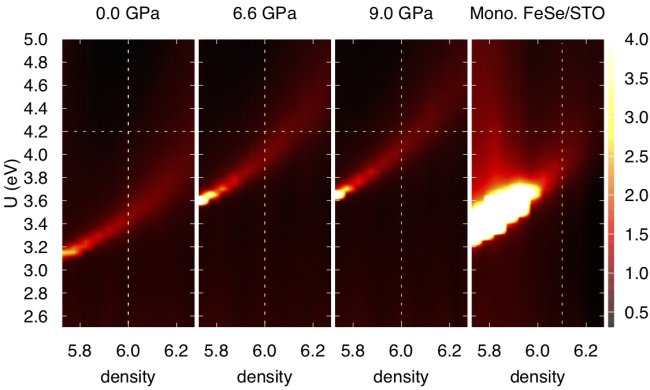Pablo Villar Arribi and Luca de’ Medici

Figure 1 : Calculated electronic compressibility for FeSe (under increasing pressure of 0, 6.6. and 9 Gpa – left panels) and for the monolayer grown on an SrTiO3 substrate (right panel), as a function of the electron density per Fe atom and of the intensity of electron-electron interactions parametrized by U. The realistic values for these parameters are indicated by the dotted lines. The zone of enhanced compressibility (light colours) gets closer to the crossing of the dotted lines under pressures. Thus the material electronic compressibility grows, like the measured critical temperature for superconductivity. In the monolayer the compressibility enhancement is very intense globally and in particular an enhancement is realized for density slightly over 6.0, where a record Tc 65-100K is measured.
Phys. Rev. Lett. 121, 197001 (2018)
Iron-based materials are presently among the most studied superconductors (with superconducting temperatures second only to those of the famous “cuprates”).
However the mechanism for superconductivity is still debated and the reason why this “critical” temperature Tc varies (between 0 and 100 Kelvin) between the materials in the family not yet understood.
In this work Pablo Villar Arribi and Luca de’ Medici, of the research group on theory of strongly correlated materials in LPEM, use realistic calculations of the electronic properties of FeSe under pressure and of its monolayer film form to point out a correlation between the calculated compressibility of the electrons responsible for superconductivity and the experimental Tc.
This could be a crucial missing piece to the puzzle, since an enhanced compressibility of the electronic fluid can be related to an enhancement of superconductivity, and an essential step towards the understanding and possibly the boost of superconductivity in these materials, in the 100 years old quest towards room-temperature superconductivity.
Reference :
Pablo Villar Arribi and Luca de’ Medici, Hund-Enhanced Electronic Compressibility in FeSe and its Correlation with Tc, Phys. Rev. Lett. 121, 197001
